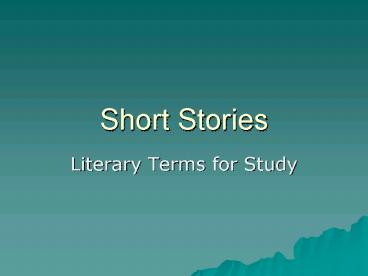Short Stories - PowerPoint PPT Presentation
1 / 31
Title:
Short Stories
Description:
Standard form of spoken or written English used for writing ... Resolution/Denouement. The final outcome of the story. Tells how things end for the character(s) ... – PowerPoint PPT presentation
Number of Views:69
Avg rating:3.0/5.0
Title: Short Stories
1
Short Stories
- Literary Terms for Study
2
Fiction
- Stories that are made up
- Not true
- Usually written in prose
3
Prose
- Standard form of spoken or written English used
for writing - Everything except poetry
- Has no rhythm or rhyme
4
Short Story
- Fictional work usually less than 40 pages
- Deals with a single conflict and theme
5
Plot
- Sequence of events in a story
- The pattern in which a conflict is resolved
6
Exposition
- Beginning of story
- Introduces setting, characters, and conflict
7
Conflict
- Struggle between two forces in a story
- Types of conflict
- Man vs. Man
- Man vs. Nature
- Man vs. Supernatural
- Man vs. Society
- Man vs. Self (internal conflict)
8
Rising Action
- When the events become more complicated in a
work - Leads to the climax
9
Climax
- Point of highest action or emotional intensity
- Turning point of the conflict
- The nature of the conflict will change as a result
10
Falling Action
- Events after the climax
- Ties up loose ends of the story
- Is a result of the climax
- Leads to final end of story
11
Resolution/Denouement
- The final outcome of the story
- Tells how things end for the character(s)
12
Protagonist
- Main character of the story
- Is followed by the action of the story
- Is not always the good guy
13
Antagonist
- The person or force causing problems for the main
character - May be human, animal, storm, etc.
- Stories with internal conflict will have no
antagonist
14
Characterization
- Methods used by an author to reveal the looks,
beliefs, motivations or personality of a
character - Two types of characterization
- Direct characterization author comes out and
tells you exactly what the character is like - Indirect characterization you must decide about
the character based on characters words and
actions
15
Character traits
- Qualities of a characters personality or
appearance - Blonde hair, blue eyes (appearance)
- Honest, fun-loving (personality)
16
Types of Characters
- Static character- does not change in the story.
- Dynamic character- changes as the result of the
storys event. - Round character- has many different character
traits, which may contradict one another. (Like a
real person) - Flat character- has only one or two traits.
17
Foreshadowing
- The subtle revealing of clues that hint to events
that will occur later in the story
18
Setting
- The time and place of the story
- Words or phrases that describe the time and place
of the story reveal its setting - Can affect actions and attitudes of characters
19
Tone
- The attitude a narrator feels toward the subject
of which he is speaking - The voice the narrator uses to talk about the
character - Example When your moms angry with you, you can
tell by the tone of her voice and the words that
she uses to talk to you or about you.
20
Situational Irony
- When you get the opposite of what you expect in a
situation - Surprise ending of a story
21
Verbal Irony
- When a character says something that can have
multiple meanings - An intentional, but true, statement that will
mislead other characters.
22
Dramatic Irony
- When the audience is aware of information that
the characters are unaware of - (When we (the readers) know something a character
doesnt know)
23
Theme
- The central message or lesson of a story (the
main idea) - Should be something the reader can apply to their
own lives
24
Symbol/Symbolism
- Using an object or repetitive theme to represent
a larger idea - (An object that stands for something else)
- Example
- Wedding rings
- A cross
- Skull and crossbones
25
Point of view
- The perspective from which a story is told
- Whose voice is telling the story?
- How do they feel about the story theyre telling?
- What is their relationship to the events of the
story?
26
First Person Point of View
- Story told from the view of someone involved in
the storys events - Will use I, Me, My, We and Us to refer
to his or her own involvement
27
Third Person Point of View
- When a story is told from the view of someone who
did not take an active role in the story - Two types of third person POV
- Limited can only give perspective with thoughts
and feelings of one character - Omniscient an all-knowing, God-like
perspective can tell thoughts and feelings of
all characters at any time past or present
28
Genre
- Different types of literature
29
Allusion
- A reference to something famous or familiar from
history, culture, literature, music, etc. - Can be a direct mention or an indirect reference
to
30
Mood
- Vibe or feeling you get from the story
- Can be determined by descriptions of the settings
and characters or the authors choice of words
31
Flashback
- A scene that interrupts the present action of the
plot to flash backward and tell what happened at
an earlier time.

